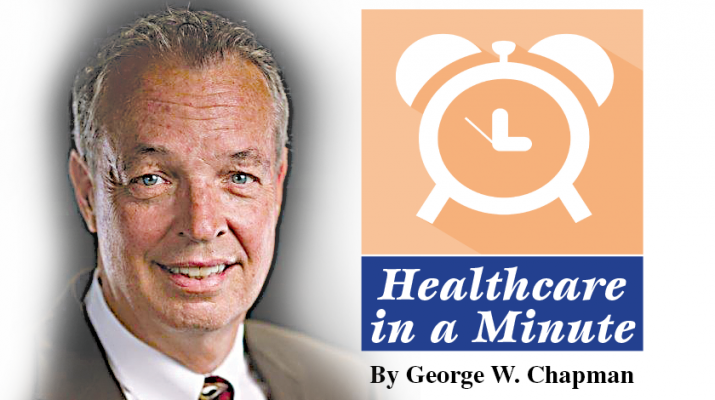By George W. Chapman
What tends to get lost in all the headline-grabbing news related to the pandemic (PPE shortages, morbidity, testing, lingering long term effects, potential vaccines, opening and closing businesses and schools, etc) is the ongoing financial crisis facing our underappreciated frontline combatants — the hospitals. Prior to the pandemic, NYS hospital bottom lines were already barely profitable, averaging a razor thin 1% to 2%. If you exclude non-operating revenue or non-patient fees like grants, donations, and interest on investments, hospitals would run in the red. A stand-alone mid-sized hospital, 200 to 300 beds, will need hundreds of millions in bailout money from the federal government. Larger hospital systems will need better business insurance. And hospitals are nowhere near being out of the woods yet. The number of cases and deaths related to the virus continue to spike in many states (not New York) primarily due to people ignoring safety recommendations. There is a $3 trillion hospital bailout bill being proposed by the House of Representatives, but its fate is not good. There are approximately 5,000 hospitals in the U.S. and that number is sure to shrink by the time we have defeated or at least controlled COVID-19.
End-stage renal dialysis
The pandemic is already being considered a “black swan” event, or something that ends up creating significant change in the world. Past examples of black swan events would be WWI, the internet, personal computers, the breakup of the Soviet Union, and 911. COVID-19 will undoubtedly make virtual medicine a staple in the delivery of healthcare. The pandemic black swan event also signals a change in dialysis. To minimize the chance of an already compromised dialysis patient getting the virus, Medicare is enhancing payments for home dialysis machines to encourage patients to stay home for treatment. There are 750,000 people a year affected by end-stage renal disease (ESRD) and 85% of them have to trudge to a dialysis center, often hours away, for treatment four to five hours a day, three days a week. Home dialysis would be a huge improvement in the quality of their lives. ESRD patients are 1% of the Medicare population, but 7% of Medicare expenses. ESRD creates all kinds of other medical problems other than dialysis. 100,000 people are on the kidney transplant list every year, but there are typically only 21,000 kidneys available. The need for donor kidneys is increasing 8% a year.
Harbinger of healthcare
If you want a reliable clue as to where we are headed, follow the money. Digital healthcare startups raised a record $5.4 billion in just the first half of this year, far exceeding amounts raised in the first half of any year since 2011. While the pandemic is driving this, one can clearly see where we are headed shortly and well beyond the end of the pandemic. “On demand” services, (just like streaming entertainment on TV), and digital remote monitoring of chronic diseases like hypertension, diabetes, cardiac arrhythmia, etc. lead the way with the lion’s share of investment. Digital behavioral health startups raised almost $600 million the first half of this year as the virus has created a significant increase in depression, anxiety and abuse.
ACA and birth control
While the future of the entire Affordable Care Act is expected to hit the Supreme Court sometime next year, the court recently ruled that any employer, not just churches, can qualify for the Portia contraceptive exemption based on religious or moral convictions. The removal of birth control coverage from an employee’s benefit package will have minimal if any impact on premiums. Interestingly, the Supreme Court vote was by gender with the three dissenters being the three female justices: Bader Ginsberg, Kagan and Sotomayor.
Opioid epidemic?
It’s back, but buried in the avalanche of COVID-19 pandemic news. Opioid-related deaths are spiking again in 30 states. Opioid-caused deaths are up almost 17%. The increase in drug abuse is most likely related to the stress and anxiety created by the pandemic. “Verily” is the science arm of Google parent company Alphabet. They are opening digital treatment and learning centers called “OneFifteen” to combat the crisis that just won’t go away. The curious name is derived from the fact that an average of 115 people died every day of an opioid overdose in 2017.
‘Retailization’ of healthcare
Walmart is getting into healthcare insurance. Yes, Walmart. Walmart Insurance Services will start selling Medicare plans this August in the Dallas-Fort Worth area market. Walmart also owns clinics that offer primary care, dental, vision, mental health and wellness services in Georgia. Walmart clinics charge a flat fee regardless on the patient’s insurance. Not to be outdone, Walgreen’s plans to open 500 to 700 primary care clinics, called VillageMD, over the next five years. The plan is to employ 3,600 primary care providers. Half of the clinics will be located in federally designated medically underserved areas. It remains to be seen how this will impact the private practice of medicine and hospital systems that also employ providers in remote, off campus facilities.
Telemedicine claims up
As further evidence of the pandemic “black swan” event, provider claims for telemedicine increased a staggering 8,300% in April 2020 compared to April 2019. Fueled by COVID-19 concerns and increased reimbursement from all insurers, to the equivalence of an in-person office visit, telemedicine is quickly becoming a more acceptable and doable tool for delivering healthcare.
George W. Chapman is a healthcare business consultant who works exclusively with physicians, hospitals and healthcare organizations. He operates GW Chapman Consulting based in Syracuse. Email him at gwc@gwchapmanconsulting.com.

